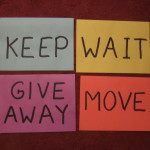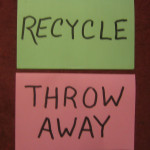 January 1: As we begin a new year, our hearts turn to resolutions but our practical sides often resist – at least after a feeble try at exercising more, eating healthier, becoming more prayerful, etc. In an effort to serve you better and clear my own life of clutter, I keep up with what professional organizers recommend and what other simple living bloggers have to say on the subject. One common practice is to START WITH EMPTY.
January 1: As we begin a new year, our hearts turn to resolutions but our practical sides often resist – at least after a feeble try at exercising more, eating healthier, becoming more prayerful, etc. In an effort to serve you better and clear my own life of clutter, I keep up with what professional organizers recommend and what other simple living bloggers have to say on the subject. One common practice is to START WITH EMPTY.
By this I mean focus on one space – a drawer, a closet, a desk, a shelf, etc. Then go through the following process:
- Choose a time and a time limit. Maybe you want to do this today, every day, once a week or once a month. It could be 15 minutes, an hour, a half day – whatever seems doable to you without feeling burdensome.
- Take everything out of the space. This has the double purpose of helping you see what you have and allows for easier cleaning.
- Clean the space if necessary. This can feel rewarding, even if you end up putting absolutely everything back that you took out.
- Review the contents of the drawer, closet, shelf. See last Lent’s series on A-Drawer-A-Day for inspiration. Separate into the categories of:

*KEEP – These are the items that are essential or bring you real joy.
*GIVE AWAY, aka RECYCLE – This is the hardest part because now, or in the near future, you need to figure out where to take it.
*THROW AWAY
*WAIT and MOVE are optional extra categories. - Put back the KEEP items. Put the GIVE AWAY or RECYCLE items in a container in an inconvenient place that will motivate you to actually take them to the person, store, recycling bin etc. (For example, next to the front door.)

- Put the WAIT items in a container that is out of the way. If after several months, a year, or whatever you haven’t missed the item, let it go. Sometimes your mind or heart needs this time to be ready to let go of sentimental items. Say good-by with reverent intentionality.
- Move the MOVE items immediately to their more logical home.
- Stop. You could of course go on to declutter another space if you still have time, but this process works best if you end with a feeling of accomplishment rather than fatigue or frustration because you’ve just crowded the rest of your day’s schedule. Crowding time can be just as stressful as hanging on to too much stuff.
The deeper side of emptying
As virtuous as it may be to empty and clean one’s physical space, there is a deeper level of emptying that you may choose to pursue. It is a spiritual emptying which involves clearing your mind and your being or unnecessary worries, stress, and self-importance. Spiritual guides call this kenosis (self-emptying).
This is a lifelong effort but is usually aided by ongoing prayer, meditation, often with the help of a faith community or spiritual coach. Yoga or Buddhist practices help some people. For me, it helps to take time in the morning for quiet and prayer. Being part of a faith community helps me check my ego lest I get too full of myself. The beauty of emptying oneself applies on many levels.
Start today. Today may just be the resolution and a plan for when the first time will be. Are you in?
PS: It occurs to me that “The Beauty of Empty” is a first world topic. People who are truly empty of food, shelter, or other necessities do not find beauty in their destitution and suffering. It’s a sobering realization that I can afford to let go of stuff.